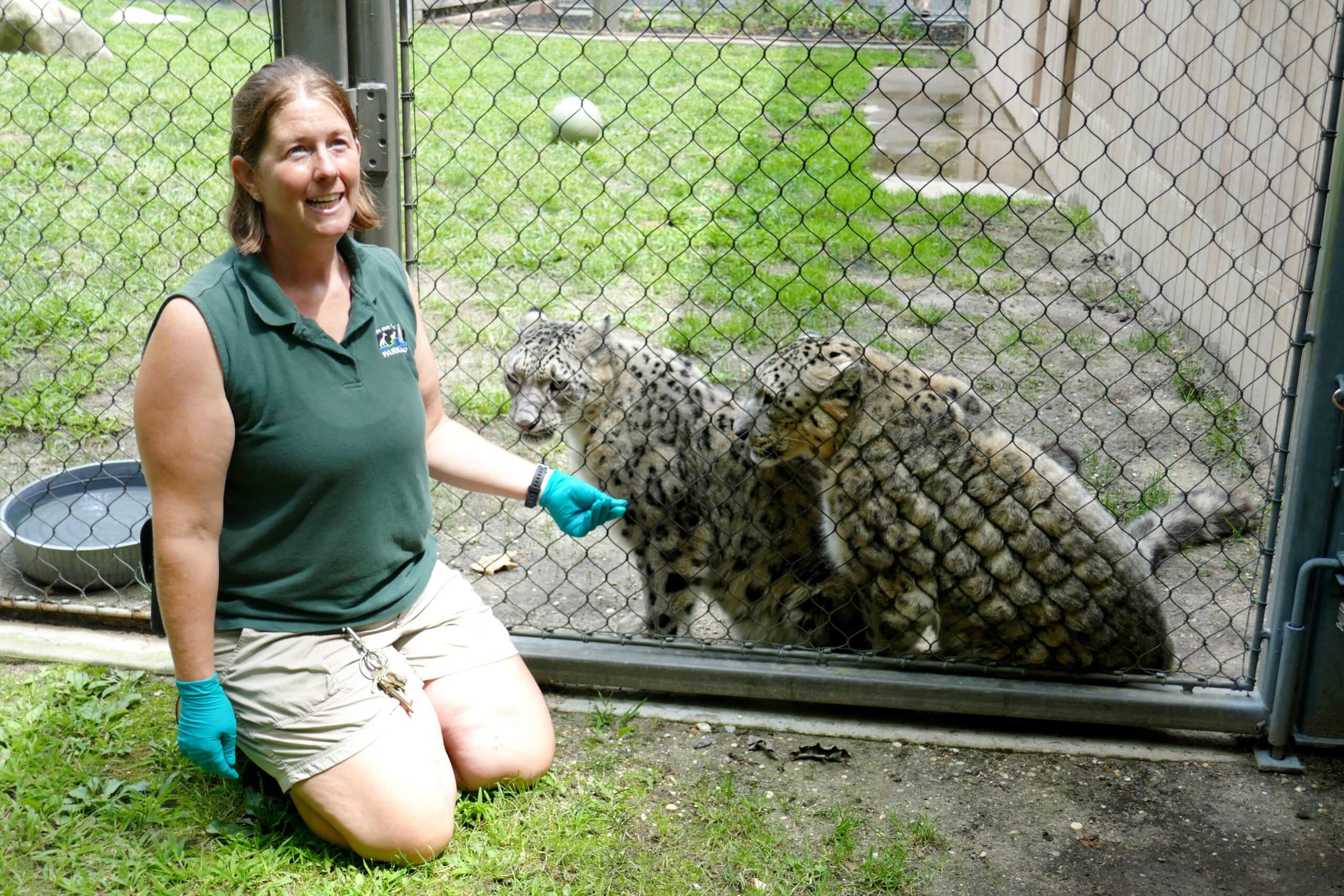“Do the Zoo” is a feature series where we go behind the scenes with zookeepers at the Cape May County Zoo.
Snow leopards are among the most elusive animals on Earth. Jennifer Berg, supervising animal coordinator at the Cape May County Zoo, said that the biomes they inhabit – the treeless alpines of Central and South Asia – are so harsh that spotting one in the wild is nearly impossible. But if you live in Cape May County, you don’t have to go far to catch a glimpse.
Why do animals like the snow leopard – uniquely adapted to some of the most remote places on Earth – live their lives on the Cape May peninsula? Jennifer made it clear: Zoos accredited by the Association of Zoos and Aquariums (AZA), like the Cape May County Zoo, help restore the wild populations of this vulnerable species.

To make that happen, zoos like ours do everything they can to replicate the conditions necessary for snow leopards to thrive. The snow leopards in Cape May County have spent their entire lives in human care; they weren’t taken from the wild and forced into captivity.
But in the wild, these camouflaged felines are prized targets for poachers, and increased human development throughout the snow leopard’s habitat has pushed the species out of places they once called home.
“Our snow leopards are part of a ‘species survival plan,’ or an ‘SSP,’” Jennifer explained.
These plans are essentially captive breeding programs, orchestrated by zoologists who possess a deep knowledge of the animal in question, with the long-term goal of reintroducing a given species’ offspring into the wild.
There are 290 kinds of animals on SSPs. AZA-accredited zoos across the country work together as a unified resource network to bolster the populations of these threatened species.
As part of the snow leopard SSP, the Cape May County Zoo is a designated breeding location. Jennifer gestured to Bataar, the zoo’s 15-year-old male snow leopard, and Maliha, his 9-year-old companion. They didn’t successfully breed this season.
“They’ll either try again next season, or they will be re-paired with other snow leopards to try again,” Jennifer said.
Scientists with the AZA play ‘matchmaker’ and coordinate the placement of snow leopards with ones that have complementary genetic traits. Bataar and Maliha are an ideal genetic match, Jennifer explained.
“We want to have genetically healthy individuals to ensure that their offspring is best prepared to live in the wild,” Jennifer said.
Jennifer spends almost every day with these leopards, as well as with the large felines found across the park. She knows the zoo’s big cats – two lions, three snow leopards, and a cheetah – better than almost anybody. But her contact with them is limited to touches through a fence. Except for the times when the leopards were very young, she has never gone near them without an intervening barrier. The risk is too great.
Still, Jennifer has a positive relationship with every feline on the property. She walked us through a small part of her daily routine on a scorching August afternoon. Bella, the zoo’s only female lion, rubbed her body against the tall metal fence that separates animal from caretaker.
“You want a scratch, Bella,” Jennifer asked as she rubbed Bella’s side through the fence.

While we spoke, Jennifer walked Bella through “target” training, when an animal is taught to touch their nose or paw to a fixed target. Today’s target was a tennis ball at the end of a stick. Bella gently touched the tennis ball with her paw at Jennifer’s command.
“Good girl, Bella,” Jennifer told the lion upon successful completion of the task, the most basic of the skills that the large felines are taught.
Jennifer clicked a small clicker in her hand, an audible sign that Bella followed the command correctly. A small treat of raw meat soon followed.
The large cats at the Zoo are taught a host of different skills.
“They’re easier to train than you might think,” Jennifer said.
Still, it might take years for the cats to learn some of the more complicated skills. “Ejection training,” where a feline picks up and discards any trash that might have been blown into their habitat, might take years.
Bella and her companion, Lex, a 7-year-old male African lion, are fed a varied diet throughout the year.
“Nobody likes to eat the same thing over and over,” Jennifer said.
Though they are carnivores, there is a great variety to be found within the meats they are fed, Jennifer said that in the wild, lions “gouge” on up to 90 pounds of meat at a time.
“They’ll eat every part of what they kill – hair, skin, bones, and all,” she said.
Like the camels that we wrote about in the previous “Do the Zoo” feature, Jennifer said that it is much easier for lions to maintain a healthy weight if they are fed more slowly throughout the days and weeks.

Some days are “light” food days. Bella and Rex might eat rabbits, guinea pigs, bones, or frozen blood on a light day. Jennifer will often hide these scraps of food throughout the lion’s habitat. On a regular day, they might eat ground beef with cartilage and bone in the mix.
African lions and snow leopards are naturally found in wildly different climates, but both are able to thrive in the Cape May County Zoo. Each animal has an off-display section of their habitat where they can find reprieve from the zoo’s many staring eyes. They also have off-display enclosures that are air-conditioned in the summer and heated in the winter.
Snow leopards, Jennifer said, naturally live in parts of the world that climb as hot as 50 degrees. African lions commonly endure near-freezing temperatures during the cool of a desert night.
Both species of large cat at the zoo rest in their climate-controlled “house” during extreme temperatures. They also enter these enclosures when it is time to eat. This lets Jennifer enter the habitat to place food. Jennifer is never in a big cat habitat while the animals are there.

There is a strict protocol that dictates how the habitat is opened, how the “house” is opened, and when the cats are let back into their habitats to eat. The house has a double set of locks, and one set of locks is always engaged.
Jennifer is there even in the worst of storms to care for the zoo’s big cats.
“Sometimes, we have to bring a blowtorch out here in winter to unfreeze the locks,” Jennifer said.
“This job is really hard work. It’s a lot of physical labor,” she told the Herald as our time together ended. “But this is my passion.”
She said that zoos are an important way for visitors to interface with the natural world, with animals that are otherwise threatened by global human expansion.
“Humans have really destroyed this world,” she said. “I believe that seeing live animals promotes empathy and excitement for conservation.”
Visit the Cape May County Zoo every day of the year except Christmas.








